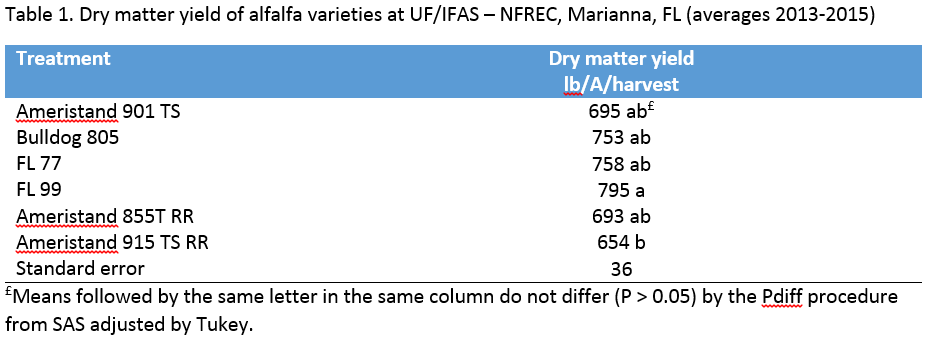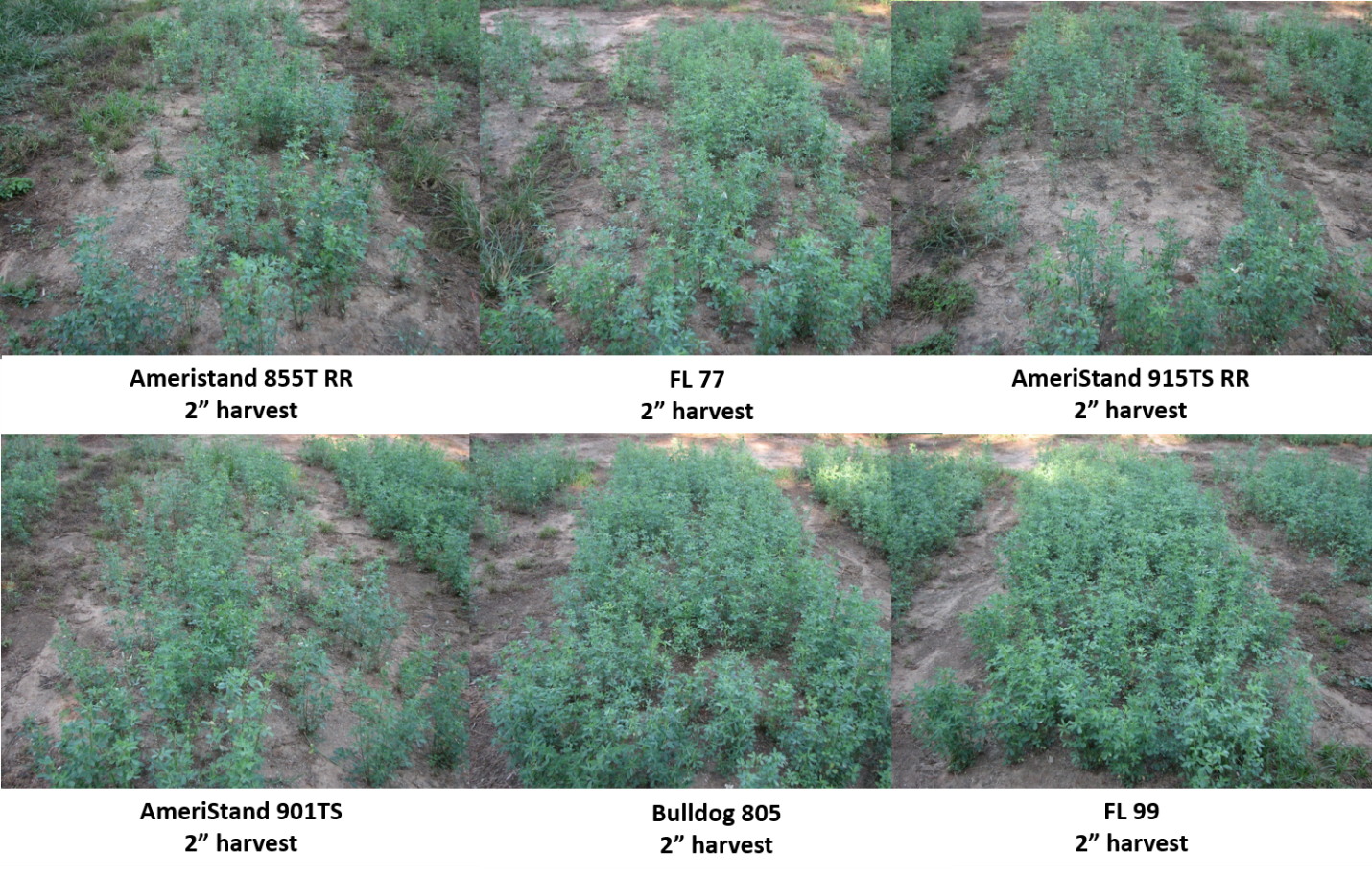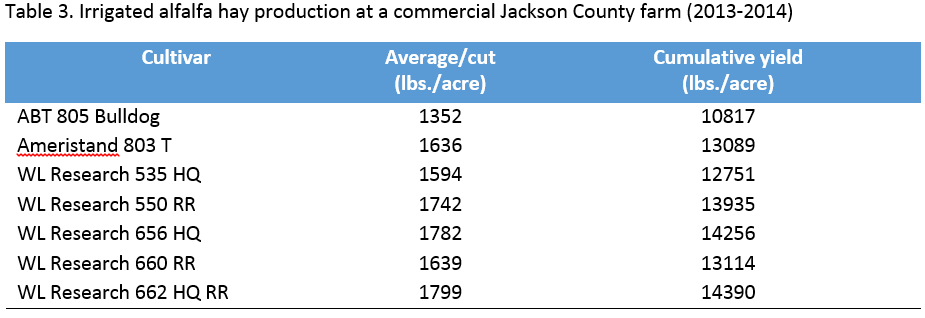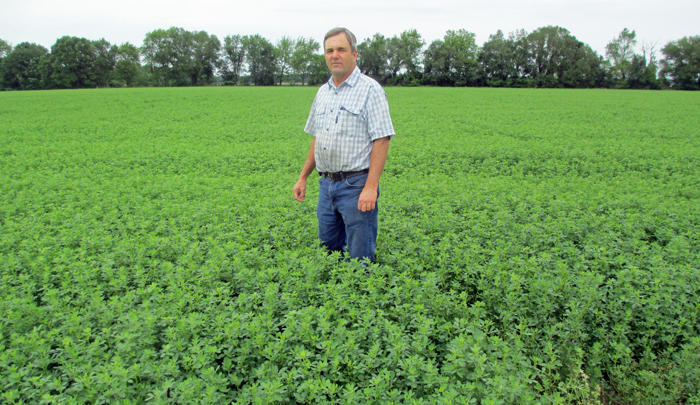J. Dubeux, Jr. and A. Blount, University of Florida/IFAS – North Florida Research and Education Center (NFREC), 3925 Highway 71, Marianna, FL
P. Munoz, University of Florida/IFAS – Agronomy Department, Gainesville, FL.
Florida has approximately 119,000 dairy cows and a well-developed horse industry that generates $6.5 billion annually. Producing local alfalfa hay is an opportunity for growers in the southeastern U.S. Reduced transportation costs compared with alfalfa shipped from other areas of the country provides local growers a potential advantage to supply the Florida market.
Alfalfa is a forage legume with high crude protein and digestibility. Alfalfa also has N-fixation capacity reducing the need for N fertilization. Alfalfa fills the gap of forage production in the early Spring and late Fall, providing high quality forage during that time of the year when warm-season forages are not actively growing.
Alfalfa requires high nutrient inputs and soil fertility, and the warm weather and high humidity during summer in Florida and in the Southern Coastal Plains increases disease pressure on the this crop. In many areas of the southeast, soil fertility is inadequate and cultivars used are not adapted to local conditions. In order to establish a successful alfalfa stand, the pH needs to be maintained between 6.5 and 7.0. Additionally, current alfalfa commercial varieties do not tolerate flooding, meaning that a well-drained site needs to be selected to establish an alfalfa stand. Combinations of these factors reduce the potential for alfalfa production in Florida as compared to other parts of the country.
One way to overcome these challenges is to breed alfalfa varieties adapted to local conditions. Fall dormancy, for example, is a critical trait that describes the alfalfa growth during the fall due to decreasing temperatures and day length. Fall dormancy scores range from 1 to 11, with lower numbers representing cultivars that exhibit less growth in the fall. Warmer regions should target non-dormant alfalfa varieties with fall dormancy > 8. Currently, several non-dormant alfalfa varieties are being tested in North and Central Florida as part of the alfalfa breeding program of the University of Florida.
For Florida production, high-yield disease/pest resistant improved varieties with a fall dormancy >8 are preferred. There are many varieties in the market for northern states, however, not many of them have been tested under Florida conditions. In North Florida, hay producers are expanding the alfalfa area (Figure 1). In North-Central Florida, alfalfa is also managed for hay on dairy farms or even under grazing conditions for purebred cattle producers (Figure 2).
In Marianna FL, six alfalfa varieties were tested (Ameristand 855T RR, Ameristand 901 TS, Ameristand 915 TS RR, Bulldog 805, FL 77, and FL 99) under two harvesting intensities (two and four inches) for two years. Because no irrigation was provided, alfalfa stands were harvested only five times during the year. FL99 was ranked among the top-yielding varieties followed by FL77 and Bulldog 805. Ameristand varieties in general yielded less (Table 1). Because FL99 and FL77 are discontinued varieties, there are no seeds currently available on the market. Bulldog 805 is the only commercially available alfalfa variety currently recommended for Florida (Blount et al., 2015). These three varieties (FL99, FL77, and Bulldog 805) presented the best stand after two years of harvest in Marianna (Figure 3).
Because FL99 and FL77 are discontinued varieties, there are no seeds currently available on the market. Bulldog 805 is the only commercially available alfalfa variety currently recommended for Florida (Blount et al., 2015). These three varieties (FL99, FL77, and Bulldog 805) presented the best stand after two years of harvest in Marianna (Figure 3).

Figure 3. Alfalfa varieties after two years of harvests at UF/IFAS – NFREC, Marianna, FL.
Photo credit: Jose Dubeux
Harvesting at a two-inch stubble height resulted in greater alfalfa productivity than did harvesting at a four-inch stubble height. (Table 2). Harvesting intensity affects tillering and regrowth after harvest by not only modifying residual leaf area and carbohydrates in the roots, but also by creating a light environment that favors plant regrowth. Overall, however, alfalfa productivity declined after the first spring cutting in 2014.  Under irrigation, alfalfa yield potential in North Florida is much greater. In an on-farm extension project, the forage team from NFREC has been measuring the yields in a commercial alfalfa field in Jackson County, Florida. The best yielding varieties averaged almost 1,800 lbs./acre per cutting, with a cumulative yield in a 12-month period of 14,390 lbs./acre. Harvest occurred every 30 days. The productivity in the second year, however, declined as well. It is important to mention that maintaining high alfalfa productivity requires fertilization after every cutting, to replace the extracted nutrients.
Under irrigation, alfalfa yield potential in North Florida is much greater. In an on-farm extension project, the forage team from NFREC has been measuring the yields in a commercial alfalfa field in Jackson County, Florida. The best yielding varieties averaged almost 1,800 lbs./acre per cutting, with a cumulative yield in a 12-month period of 14,390 lbs./acre. Harvest occurred every 30 days. The productivity in the second year, however, declined as well. It is important to mention that maintaining high alfalfa productivity requires fertilization after every cutting, to replace the extracted nutrients. Alfalfa production is an option for North Florida. Alfalfa varieties FL99, FL77, and Bulldog 805 are among the best options, however, only Bulldog 805 is currently commercially available for producers. Although alfalfa productivity declined after the spring cutting of the second season, the shorter longevity of alfalfa stands observed in Florida, as compared to Midwest production regions, might be compensated for by the additional price paid in Florida for alfalfa hay.
Alfalfa production is an option for North Florida. Alfalfa varieties FL99, FL77, and Bulldog 805 are among the best options, however, only Bulldog 805 is currently commercially available for producers. Although alfalfa productivity declined after the spring cutting of the second season, the shorter longevity of alfalfa stands observed in Florida, as compared to Midwest production regions, might be compensated for by the additional price paid in Florida for alfalfa hay.
Literature Cited
- Grazing Cover Crops is a Triple Win! - August 15, 2025
- How are My Cool-season Forages Recovering from the Snowfall and Low Temperatures? - January 31, 2025
- Integrated Crop-Livestock Systems Improve Soil Health - July 26, 2024


